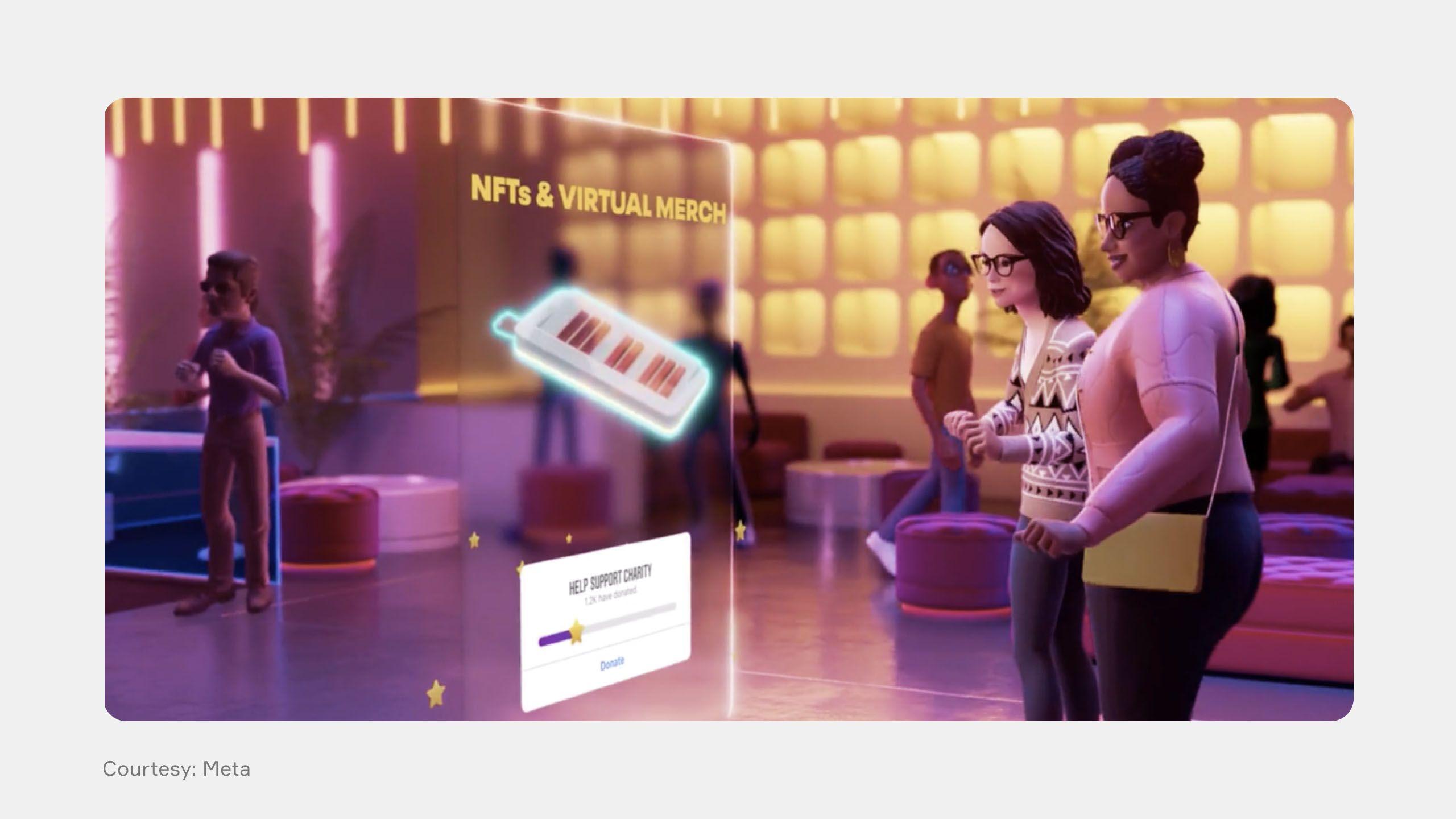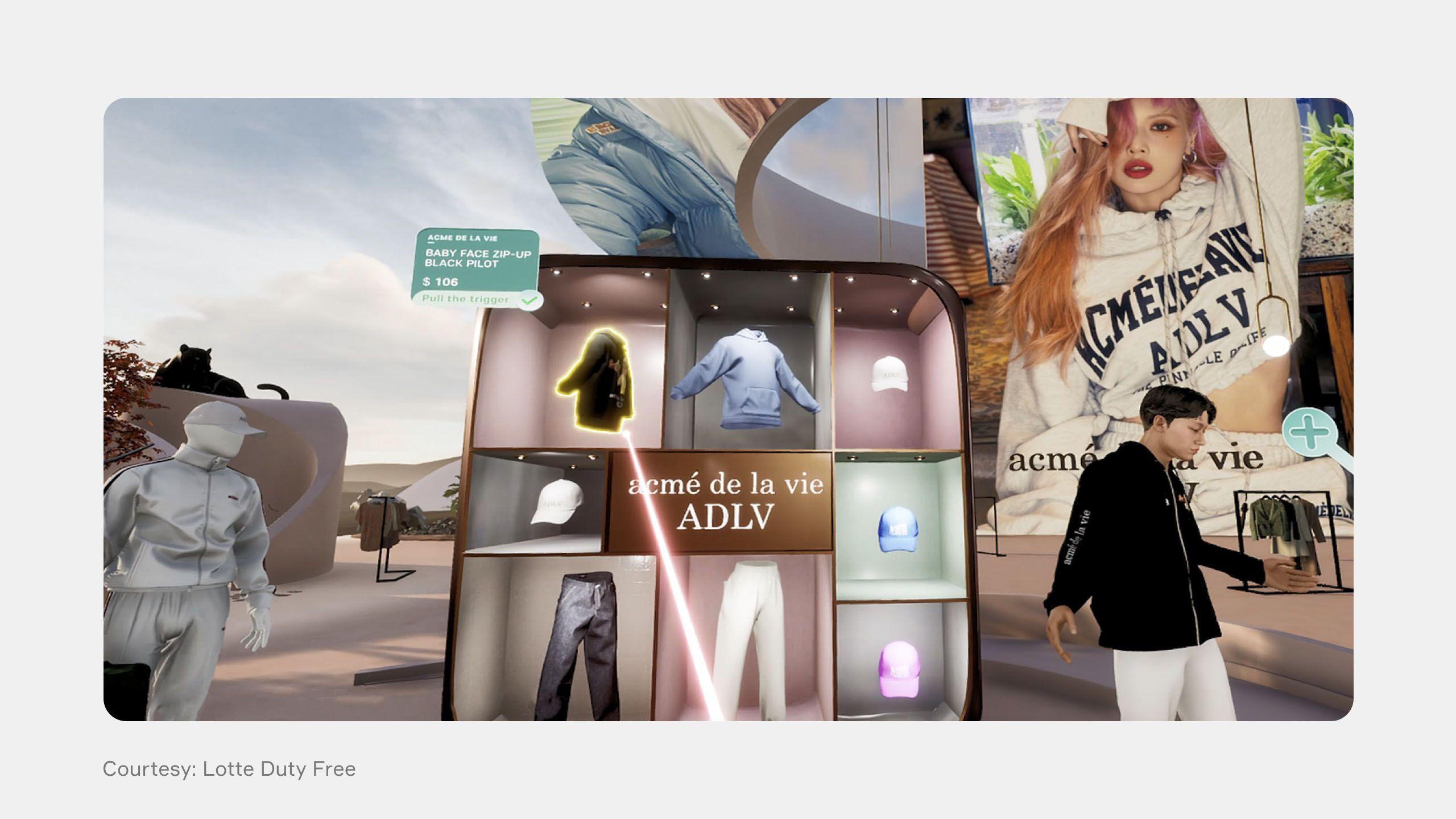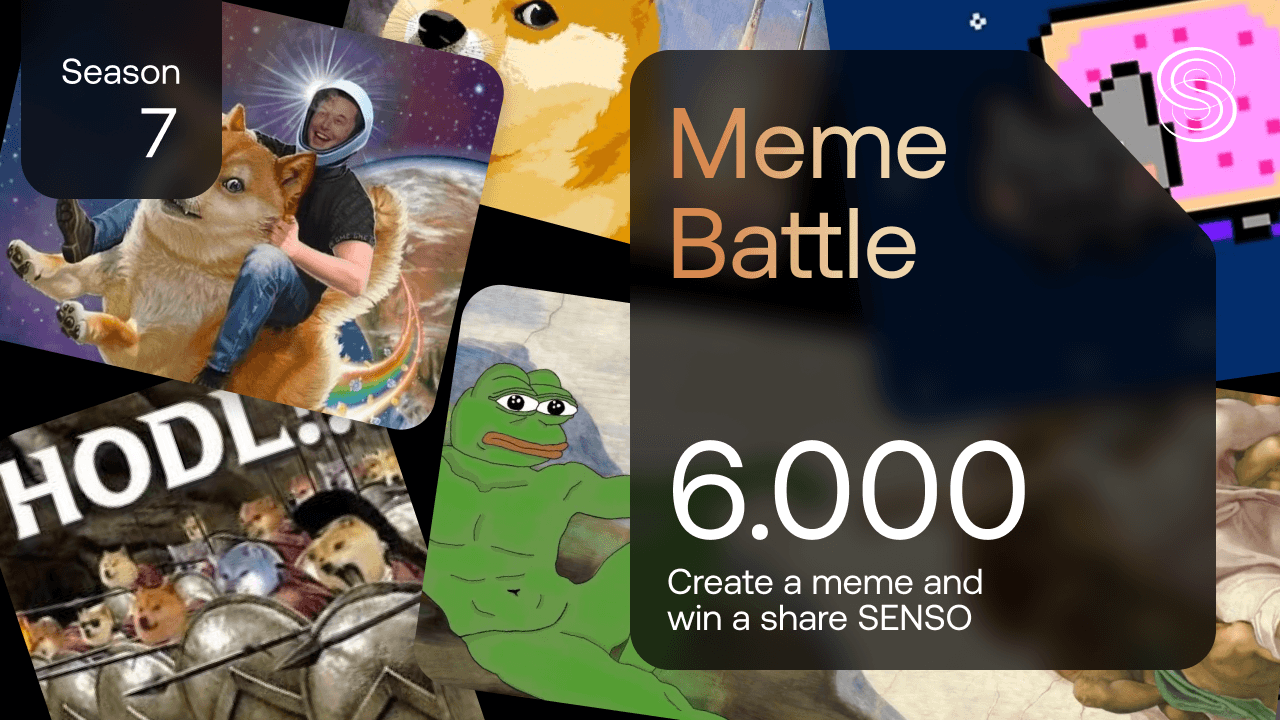As we usher in a new era in technological innovation, it's becoming apparent that brands and consumers will interact very differently in the Web 3.0 world - and the metaverse that is emerging from it. By blending physical with digital, we will see the rise of hybrid experiences where immersion, personalization and connectivity will become some of the key selling points.
And with new patterns of behavior and consumption slowly taking shape, brands will have to re-invent themselves to align with audiences in the metaverse. What is important to take note of is that the marketing of today will not translate well in a virtual world; from advertising to purchasing channels and the very nature of the interests of consumers, marketers and advertisers will face a new set of challenges.
The metaverse is being billed a trillion dollar market opportunity. Some brands with deep pockets like Gucci, Louis Vuitton and Ralph Lauren, are already carving out their influence in the metaverse - and making big money with their first forays into virtual worlds. Even for those who aren’t willing to commit just yet, brand experimentation has become a top trend to follow.
And while we’re just at the tip of this technological advancement, there are already real-world areas that can benefit from having a presence in a virtual world. Perhaps without much surprise, advertising and marketing are likely to become an even bigger industry in the metaverse given the new (and extremely profitable) avenues that are being opened up.
In this post, we will be discussing advertising in the metaverse, from the advertising channels of the future to the pros and cons of embracing this technological development.
What Is The Metaverse
The metaverse is a virtual space that blends real world and virtual realities into one, in real time, using emerging technology like virtual and augmented reality to create highly immersive 3D environments. Some are calling it the successor to the current internet, as the next big step in interactive digital experiences.
With a vast number of possibilities at play, the metaverse is quickly becoming an influential platform for socialization, creative pursuits, business, gaming, entertainment, and more.
Currently, the closest experience we have to the metaverse are gaming platforms like Roblox , Axie Infinity and Fortnite, as well as open-source virtual worlds, including Decentraland, and the Sandbox. These platforms offer shared 3D worlds where users can engage in a number of experiences beyond gaming.
In Sensorium Galaxy, for example, users will be able to attend music concerts and meet their favorite artists, as well as move within the many worlds within this metaverse, connecting with new people, exploring new forms of self-expression and exploration, creating dances and striking relationships with virtual AI-driven beings. Users will also be offered deep levels of customization of both their avatars and their experience with Sensorium Galaxy.
With virtual worlds becoming the new marketing and advertising frontier, there are a key metaverse concepts that advertisers will want to leverage:

Hyper social: opportunities to meet and connect with new people will become much bigger due to the shared nature of virtual worlds.
Scalability: Hundreds of millions of people (and their avatars) will be able to coexist, at the same time, in the metaverse.
Accessibility: All users, regardless of their age, background, religion or location, will be able to join the metaverse.
New forms of content: Immersive and interactive content generated by users and that can’t take shape in the real world, can finally emerge in the metaverse.
Bridge between physical and digital: Blurring the lines between both worlds allows people to interact with experiences, products and services in more compelling ways.
Key Metaverse Terms Advertisers Should Know
As we explained in our last article ‘Metaverse Meaning: Definition, Origin and Opportunities’, the term metaverse is a combination of the Greek prefix “meta” (meaning beyond) and “verse” from the word universe. The concept was first coined by Neal Stephenson in his 1992 novel ’Snow Crash’.
However, only in the last year has the metaverse really exploded, entering the mainstream on the back of big tech news like Facebook’s rebrand as Meta at the end of 2021.
Since then, the metaverse has gone from being a tech buzzword to becoming a major area of investment for companies across all industries.

Brands will no longer be limited to physical spaces — or physical products — as the value of digital goods (in the form of non-fungible tokens), keeps growing. The idea is that instead of going to a physical store and picking up your favorite products, you could simply purchase them in the metaverse and get them delivered at home. Sounds like Deliveroo, we know, but in the metaverse there’s much more than you can do at the same time you’re shopping, like attending a metaverse concert or gathering with your friends.
Experiences will be increasingly integrated into one space, creating more opportunities for users. Or that’s at least the plan of companies like McDonald’s, which will be adding a whole range of services to its standard home delivery options.
Before we get to the details, it’s worth taking a look at the key metaverse ideas that advertisers and ad ad agencies should be aware of:
Virtual reality (VR)
Virtual reality is an immersive and interactive experience in a simulated environment. You can enter a 360-degree environment with the help of an interface like a head-mounted device. This way, VR provides visual, sensory and auditory feedback, allowing users to immerse themselves fully in virtual worlds and environments, like the metaverse.
Virtual reality technology has been around for quite a while now, but it has only started maturing and becoming more accessible in recent years. More recent advancements have made the use of VR and its interfaces, like VR headsets, much more practical, widespread and accessible.
Augmented reality (AR)
Augmented reality is a technologically enhanced version of the real world, achieved by superimposing a computer-generated image in a real-world, physical space. Visual and sound stimuli are added to enhance immersion.
Mixed reality (MR)
Mixed reality is a broad technological category that refers to “mixed” experiences that result of an overlap of human and computer processing input. As described here, Mixed reality technology overlays artificial content onto the real world and enables the artificial content to interact with the real world scenery. VR and AR lie on the mixed reality spectrum, which extends between physical and digital worlds.
Extended Reality (XR)
Extended reality encompasses virtual reality (VR), augmented reality (AR) and mixed reality (MR), and any form of immersive technology capable of extending reality by blending real-world elements and virtual world. XR includes human-machine interactions that have an effect on cognition and senses, like VR headsets, AR glasses and even implants.
Avatar
An avatar is a computer-generated representation of users in a virtual world or metaverse. In essence, it’s your virtual persona.
Blockchain
Blockchain technology provides a way to store information digitally that is nearly impossible to change or hack. Blockchain also powers cryptocurrencies, like Bitcoin and Ethereum, as well as being the technology behind non-fungible tokens (NFTs).
Cryptocurrency
Virtual currency, or cryptocurrency, is the main means of payment in the metaverse. This type of currency is kept in digital wallets and secured through highly complex cryptography. There is no central regulation or oversight over cryptocurrency as it goes through decentralized systems, which help issue and track cryptocurrency tokens.
Non-Fungible tokens (NFTs)
An NFT is a unique digital asset stored on a blockchain. It represents real-world items like music, art, collectibles, and much more. And NFT will give you true digital ownership of a one-of-a-kind asset.
Ways To Advertise In The Metaverse
So, how can brands advertise in the metaverse and profit from the technology? As the metaverse is far from being a fully-formed platform, we can’t predict the full scope of opportunities, but there are a few trends emerging. Many are an extension of real-world, tried-and-tested strategies including:
1. In-metaverse Advertising

Ok, granted. This might not be the most exciting development, but digital advertising isn’t really going anywhere. In some metaverse-like platforms, including Roblox, Fortnite and Decentraland, you are likely to come across some form of metaverse advertising, most commonly a virtual billboard. This is a model that has worked well for in-gaming advertising in platforms like Tiki-Taka Soccer and FIFA Mobile, and can translate well in the metaverse. Certainly taking note of the potential, brands like Coca-Cola, Samsung, Balenciaga and Adidas are doubling down on their presence in the metaverse, with splashy PR and advertising campaigns to match. But while a billboard or a banner might seem old-school IRL, they’re an untapped channel in the metaverse, still.
2. Virtual Influencers

Influencer marketing is one of the most powerful tools to advertise and sell products these days. And while that might not change in the metaverse, brands are increasingly exploring partnerships with a new breed of social media stars - virtual influencers. There are many upsides to this strategy, from making more creative campaigns to being most cost efficient. Virtual models are also more easily manageable, which can be another great advantage for some advertisers. Influencers like Lil Miquela, Shudu and Imma frequently nabbing high-profile campaigns with the likes of Calvin Klein, Balmain, Valentino and Dior. That isn’t to say that human influencers won’t have a place in the metaverse. As mentioned by marketing consultancy group R3, users will still be able to follow digital influencers the same way they do now, while brands will continue partnering and collaborating with various influencers to “make a splash” in the metaverse.
3. Metaverse Events

Fortnite and Roblox have led the way in reaching large scale audiences with entertainment events like concerts by the likes of Travis Scott, Lil Nas and Ariana Grande, each pulling in millions of fans. Just like in real-life with massive events like, say, the Super Bowl, metaverse concerts, summits, sports events, etc, are incredible advertising opportunities. From rolling out full-on ads to more subtle product placements, consumers are going to interactive advertising across the metaverse.
4. Metaverse Commerce

One of the key trends emerging has been the rise of the direct-to-avatar (D2A) economy, where brands sell digital products targeted at enhancing user’s avatars. These digital goods can already count on a massive market potential, in line with in-game spending trends we’ve seen in recent years. In 2025, the market value of in-game purchases is projected to surpass 74.4 billion U.S. dollars.
Much of the hype has to do with the use of non-fungible tokens to support virtual economies. In the metaverse, digital goods are exchanged as NFTs, which makes them entirely unique while ensuring their ownership is protected. These assets can range from content to collectibles, and so far they’ve proven to be a highly monetizable market.
Nike, for example, has become a permanent fixture in Roblox where it established Nikeland. This virtual showroom is filled with virtual racks of Nike NFT shoes, clothes, and accessories which users can easily purchase and wear in the metaverse. Coca Cola recently launched its own collection of NFT wearables in Decentraland, to which it has now also added a metaverse drink. A raft of other brands, including Gucci, Tommy Hilfiger, Samsung, Wendy’s and McDonald’s are also offering NFTs across virtual worlds.
Why Is The Metaverse Lucrative For Advertising
Although it’s predicted to balloon into a multi-trillion dollar industry), for now the metaverse remains an affordable destination for advertising. The prices of running a campaign or renting a metaverse billboard aren’t particularly high, making it a potentially lucrative opportunity to target new audiences entering the metaverse.
Not only is advertising in the metaverse a novel tool, but it will also have a far wider reach when compared to traditional marketing and advertising strategies.
Brands will, in particular, want to target millennials and Gen Z audiences, as those are already largely familiar with digital experiences and virtual worlds, particularly in gaming. There are currently nearly three million active gamers in the world. In the U.S. alone, 68% of American adults (163.3 million) are gamers, while 70% of American kids aged 18 and below (or 51.1 million) are gamers, too.

In addition, with crypto and NFTs becoming increasingly mainstream, these segments are only poised for massive adoption and growth in virtual worlds. In fact, the metaverse is already becoming a leading destination for NFTs, with even famed auction house Sotheby’s launching a virtual gallery in Decentraland.
Finally, with real-world limitations out of the way, advertising in the metaverse can reach new heights - without breaking the bank. Take for example Gucci’s uber successful Gucci Garden campaign, a virtual recreation of one of the fashion house’s most fantastical advertising campaign sets. Inside this virtual space hosted inside Roblox, users (avatars) could walk through a forest-like scenario, completely open to the sky, while also browsing through Gucci’s digital fashion collection.
As a result of this activation, the famed Italian fashion house managed to sell a virtual bag for more than its real-life counterpart.
Key Benefits of Metaverse Advertising
Throughout history, advertising has been quick to embrace new trends and technological leaps. The metaverse is now opening, again, a new era to be tapped into - and a new platform through which advertisers and marketers can reach audiences. As such, brands need to start considering taking the first steps to embrace virtual worlds, with some of the top advantages of advertising in the metaverse being:
Unlimited turnout
A metaverse has no limit to the amount of people that can enter it - and experience it concurrently. This means that advertisers can reach an unlimited audience, something that technology doesn’t currently allow as there are very few events that can gather millions of people at the same time in one place.
Boundless infrastructure possibilities
The sky's the limit when it comes imagining and conceptualizing the metaverse. Without the restraints of the real-world, like gravity, lack of space or even budget, there’s nothing in the way to what can be built in a virtual world. Whatever you dream, that can become possible in the metaverse.
High-volume monetization
Through blockchain and smart contracts, the metaverse promises to give its users true ownership over digital assets. This is an enticing prospect for creators. Artists can easily mint their art pieces or content and sell it as an NFT, meaning they’re a one-of-kind digital asset. Some celebrities, influencers and content creators are also using this technology to connect with fans and followers in more meaningful ways, including releasing exclusive content that goes straight to buyers.
Personalization
In recent years, marketing and advertising has shifted from a “one-to-many'' to a more personal “one-to-one” approach, with ads becoming ever more tailored to the people they aim to reach. This is a strategy that’s been particularly important to capture the attention of younger generations, who don’t want to feel just like another, faceless person in a big audience. Leveraging the potential of VR, AR and AI to forge deeper relationships with customers in the metaverse is a must-follow strategy for brands who want to become relevant and engaging in the metaverse.
Why Should Brands Advertise in the Metaverse
First mover advantage
As the saying goes, the early bird catches the worm. The metaverse is, for now, a novelty about which there’s still relatively little understanding. But that presents an opportunity for those ready to learn about it - and take the challenge head on. There’s no need for a big commitment like opening up a virtual store and having a permanent presence in the metaverse. Brands can opt for experimenting with smaller advertising, like buying a banner within a game or a virtual music concert, or using AR to increase engagement.

Innovative cross-channel mix
Part of keeping up the trends is updating strategies to match not only changing consumer behaviors but also the channels that are the most important to audiences. With more people entering the metaverse, it’s worth taking a look at what is behind the move and study the evolution of behaviors and interests. Just like the first users and brands that embraced Facebook or Instagram, so too the metaverse will be a relevant channel for consumers. Having a presence there, even if small, can make a difference in the long run. On the other hand, the metaverse is the perfect creative asset for advertisers, who can run real-world campaigns in parallel to actions in the metaverse.
Endless Creative Possibilities
The metaverse is a blank canvas where creativity can be fully unleashed. With the laws of physics out of the way, advertisers can make use of innovative tools to conceptualize campaigns. Currently, we’re seeing a growing disinclination and indifference toward advertising. Many consumers, including you maybe, are proactively avoiding ads and paying for ad-free experiences. However, this doesn’t have to be a reality in the metaverse as there will be more ways to engage users. This means appealing not just to their eyes and ears, but to all their senses. Multi-sensory simulation in the metaverse will be made possible, in great part, thanks to the use of haptic technology, allowing users to have a real sense of presence and contact with their virtual environments in ways that aren’t possible today.
Challenges of Metaverse Advertising
While the metaverse is a very tempting platform for marketing and advertising, there are a few caveats to be aware of before jumping in.
Security
Now more than ever, data privacy is at the top of consumer’s concerns - and demands. Without clear cybersecurity protocols in place, it will be hard to bring in adopters and convince them to engage with brands in the metaverse. It might be that, at the end of the day, it will be up to brands to ensure that their digital presence and footprint remains safe.
Regulation
Tech giants have faced increased scrutiny over their perceived failure to adequately moderate and regulate content on their platforms. The issue will prove equally as relevant in the metaverse, whose very nature relies on decentralization. With such a model, self-regulation will be key. But even so, with users regulating other users, as is the case with platforms like Decentraland, the issue could still prove elusive. A solution might be using smart contracts to stamp inappropriate content or tackle misinformation.
Lack of adoption
Consumer adoption of the interfaces needed to enter the metaverse, in particular VR headsets, is picking up pace but it remains low for now. The same goes for the adoption rate of VR technology more broadly, with user experience being frequently singled out as one of the top barriers to mainstream adoption. Adding to a relatively slow hardware adoption, there is also a hurdle tied to virtual reality content, which has also experienced an underwhelming reception so far. Data from Forrester has found that only 34% and 28% of US and UK online adults, respectively, are excited for what the metaverse will offer, and less than 25% in both countries demonstrate the kind of intense gaming and social media activities conducive to metaverse early adoption.
Measuring Metrics
Measuring and tracking can be particularly challenging in the metaverse as there are no clear metrics in place. One of the biggest challenges has become assessing return on investment, a key metric for any advertiser and marketer. Without knowing exactly what they’re getting out of their money, it’s challenging to justify budgets to advertising clients. As explained by Cathy Hackl, brands might struggle in the beginning to assess potential OKRs [objectives and key results] and the potential ROI, as even projections on numbers are constantly evolving. It’s only likely that in the metaverse, marketing metrics will go beyond just likes, subscribers and shares.
Tips to Get Started with Metaverse Advertising
So, what will advertising 3.0 look like? Hard to tell. We are yet to enter a full-fledged metaverse. But brands have started experimenting with some tools and strategies that will certainly payoff when it comes to advertising in the metaverse:
Augmented reality marketing
Unlike virtual reality, which depends on VR headsets and more complex data, augmented reality is a tool much easier to use as consumers need only their smartphones to access AR-based experiences. Brands like Zara) and Chanel, for example, have experimented with AR technology to enrich their shopping offerings, while social networks like Instagram and Snapchat have a vast selection of AR filters. Augmented reality is a way for marketers to interact with customers they may not have had access to before, opening up new opportunities for personalization, leading to more successful campaigns in the long run.
Virtual reality advertising

Virtual reality is the latest technology to get the full attention of advertisers. It has the potential to be more immersive and interactive than any other form of traditional advertising. Virtual reality advertising can be used for many purposes, including product demonstrations, 360-degree videos and virtual tours. Recently, Meta announced that it would be integrating 3D ads to Facebook and Instagram advertising, saying the step will help consumers have a better understanding of the products they engage with online.
Video marketing
Video marketing is already one of the cornerstones of today's marketing practices. In the metaverse, it will include videos linked to specific themes related to customers and appear as part of personalized presentations. As predicted by industry experts, metaverse video marketing will make use of technology like eye and motion capture, facial expression recognition and voice recognition, allowing advertisers to use it as a metric to better gauge the feedback of viewers regarding a product or piece of content being presented.
Live streaming
As a shared space where users can easily hang out with others like friends and family, live streaming is another tool through which connection can be achieved. Live streaming brings in an element of real-time presence and connectivity, which advertisers can continue using to their advantage, as they already do in platforms like Meta, Instagram or Twitch.
Bottom Line
The metaverse is yet to fully emerge but it is already presenting opportunities for brands to market their products and services more creatively. Not only can advertisers use innovative tools to reinvent their approach, virtual worlds also open the door to engagement with wider audiences, at a scale so large that is nearly impossible to currently replicate. Hopefully, our guide has helped you get a better grasp of what is advertising in the metaverse and some steps you can start taking now to kickstart your metaverse experience.




